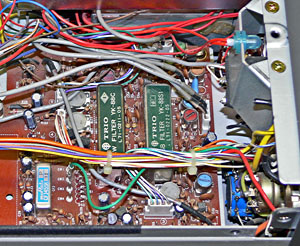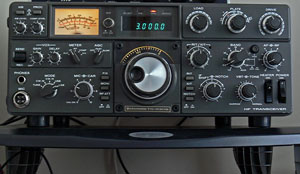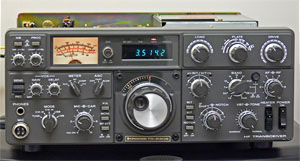
Another EBay acquisition. Very little information except that it was working. This was verified, though the case had a "ding" on the bottom half of the case requiring straightening out. This was achieved by the careful use of a pillar drill being used not as a drill, but a press!
As acquired it was rather grubby and dusty internally, having clearly had a lot of use, though not necessarily abuse. The radio was cleaned up inside using a dry paintbrush and a vacuum cleaner. Some photos of the rig in its "before" and "after" condition are on my FlickR site.
No additional IF filters were fitted. The Kenwood variable width circuitry meant that this was not a major operational impediment.
Update December 31st 2009
A YK-88C filter bought from an EBay trader in the US has been installed! The radio was 23 years old before it was so treated!
The filter installation wasn't quite as straightforward as the instruction manual would have you believe. This is due to a lot of internal interconnecting wires either connecting to, or traversing the IF board making it impossible to lift the IF board without judicious unravelling of some of the wiring harnesses, and the careful removal of three multipole header plugs on the board itself. However all was completed in the end.

The results are, however most pleasing. As my preferred mode of operating is CW, this is a real bonus.
Whilst I had the radio on the bench I tweaked the IF offsets for LSB and USB to ensure they perform as similarly as is possible - I tend to go for a "mellower" sound at the expense of the higher frequencies. I find this a more pleasing sound, though it may not be the best from a "DX" point of view, but as I have said many times, I'm not a DX chaser! My methodology for doing this is to feed the output from the radio into my "radio PC" running the "Spectran" software. The receiver is tuned into some white noise, and the frequency response of the IF passband shows up on the Spectran screen. The oscillator trimmers are adjusted so that the USB and LSB have as similar a response as possible. There is a degree of compromise of course, but in practice the responses can be adjusted so the difference between them is barely noticeable.
Now having operated the radio for some hours I believe there to be one or two alignment issues which need to be looked at, in particular the "Notch" function appears not to be working correctly.
Update January 1st 2010,
Oops! I spoke too soon!
After running the rig for an hour or so this morning, the digital display has stopped working. The display just shows the band offset frequency (e.g. 3.000MHz on 80m) and doesn't count the VFO-derived frequency. Allowing the rig to cool down and repowering makes no difference, the fault is solid - this suggests component failure or similar.
If I am unlucky the LSI chip will be u/s, but there are a number of other possibilities, including the major disturbance to the rig wiring whilst I was installing the CW filter yesterday. The radio will be back on the test bench for investigation, but maybe not today, it being New Year's Day and all - I have a bit of a sore head at the moment!

Update January 4th 2010
Panic over! The last mentioned possibility appears to have been the culprit - all the wiring I disturbed whilst fitting the CW filter caused the problem.
Lifting the lid (carefully) with the power on jogged the display into life again, reseating the header plugs on the display board appears to have made this cure permanent. Phew!
Curiously, a few days after this event, whilst giving one of my TS-530S a run out, the identical fault occurred on that rig, except that I hadn't had the cover off for any reason. However, upon removing the cover and "exercising" the multi-pole header plug which carries the VFO sample to the digital readout board, normal output was restored!
